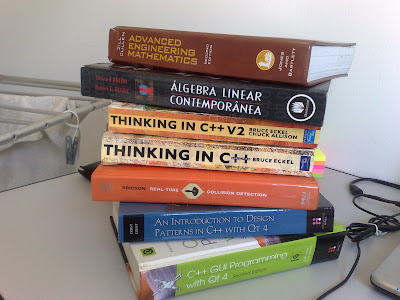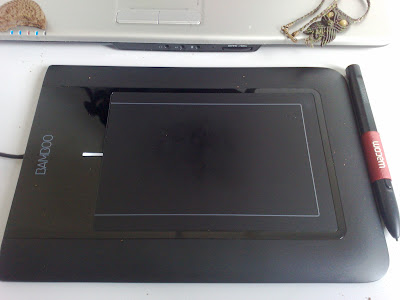Last year I bought a Wacom Bamboo tablet to enjoy my free time studying some digital art with Krita and MyPaint. I lent it to my girlfriend for a few months after 2011 Christmas so she could have some fun too. Angela was here in Natal last week (while the Lakademy was happening in Porto Alegre, south of Brazil ) and she brought it back. I askd her to bring it to me so I could use it while I am working in my GSoC project.
 |
| just a test i made when Krita 2.4 was still in Alpha 3 |
It takes some time to get used to this kind of input device but after that it’s really fun to do things with it. I really love drawing, but the reason why I bought a tablet was that my painting skills it’s quite low. I get jealous very easily from other artists works.
Anyway, another point: Angela bought my Qt4 book too, since I had left it in Teresina after I moved to Natal.
I am not a KDE (not even a Qt ) experienced programmer, so the book will help a lot in some things I am doing. For instance, I corrected some points in my granular particles simulation and now I have some right values in it’s output. Although some errors persists, I got some key values right. It’s just some numbers in a text file, but as soon I eliminate some Batman lyrics (NaNs are one of my nightmares), the next step it’s to pass the generated values to a sequence of QImages and see if the particles got the right pixels and the right movements.
 |
| a speed painting Angela made with my wacom |
As I said in previous posts, this project it’s not a easy one. It requires a real-time approach to a not so common particle type. The simulation I did have some serious performance drawbacks. For just a few particles (200 particles in the data set randomly initialized and distributed in a euclidean plane of size 100×100 units) the simulation takes almost 3 minutes to run 1000 steps, with a few wrong outputs !! It’s a really bad result.
After that, I gathered a handfull of books related to the topic. Physics and engineering are the fundamentals, but a real-time approach it’s the more important feature in the project. I got a book with my university advicer about real-time collision detection in the hope that it will help me do a better job in this simulation.
 |
| Real-time collitions, linear algebra, engineering math and Qt/C++ : the tools for the job |
Another point is that I’m thinking of trying to see the actual state of it using a OpenCL approach. I have access to a relative good computer in the university: a i3 intel processor with 4Gb of RAM with a NVidia graphics board. With that, what need to be done it’s some self-training in this tecnology. I never coded in OpenCL before and the talk around here is that it’s really hard. I check it out with a few OpenCL tutorials and I have to agree with the guys: it’s really tough. A simple hello world pass through all kinds of concepts, from context creation, through devices association to kernel programming. Fortunately, I found a few books about it too.
Anyway, if you want to check it out the actual state of my simulation, the repository is hosted in my gitorious account. I did not allowed merge requests since the code it’s quite unstable, but it’s well commented and have some references if you want to understand it better. I’m already writting another post with the theory behind the simulation, doing a more extensive and well detailed explanation of the concepts (some few drawings and formulas for our enlightment ![]()
Until next round!




0sem comentários ainda